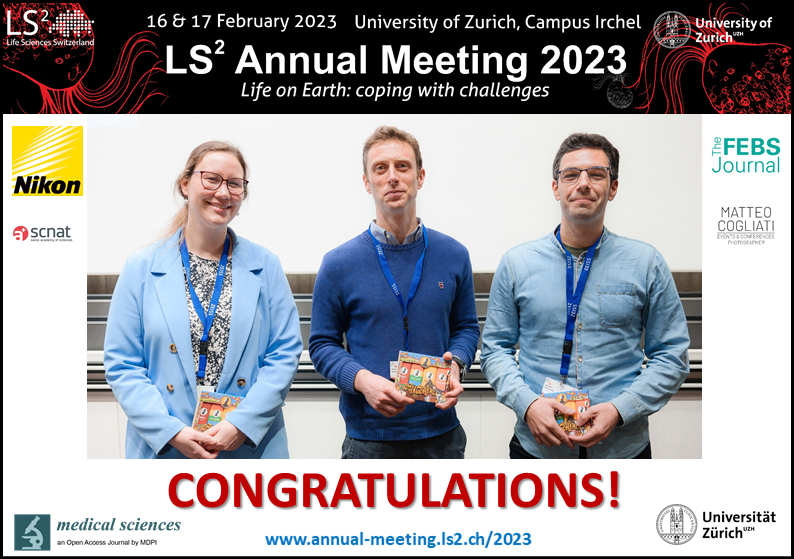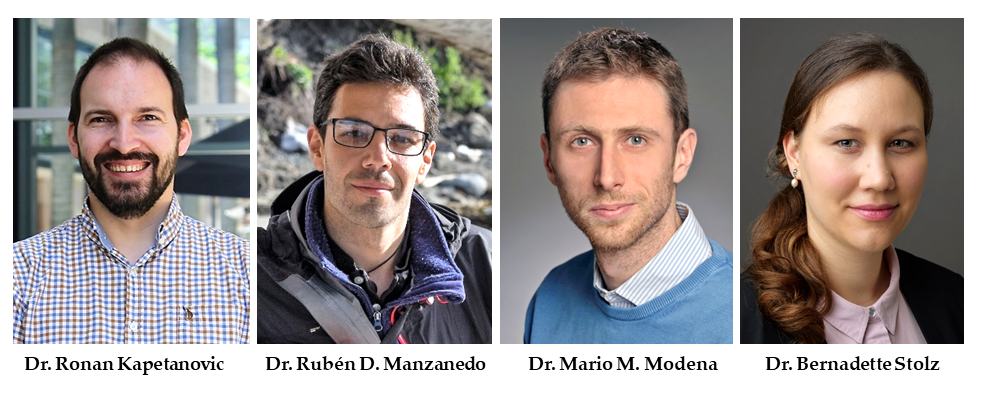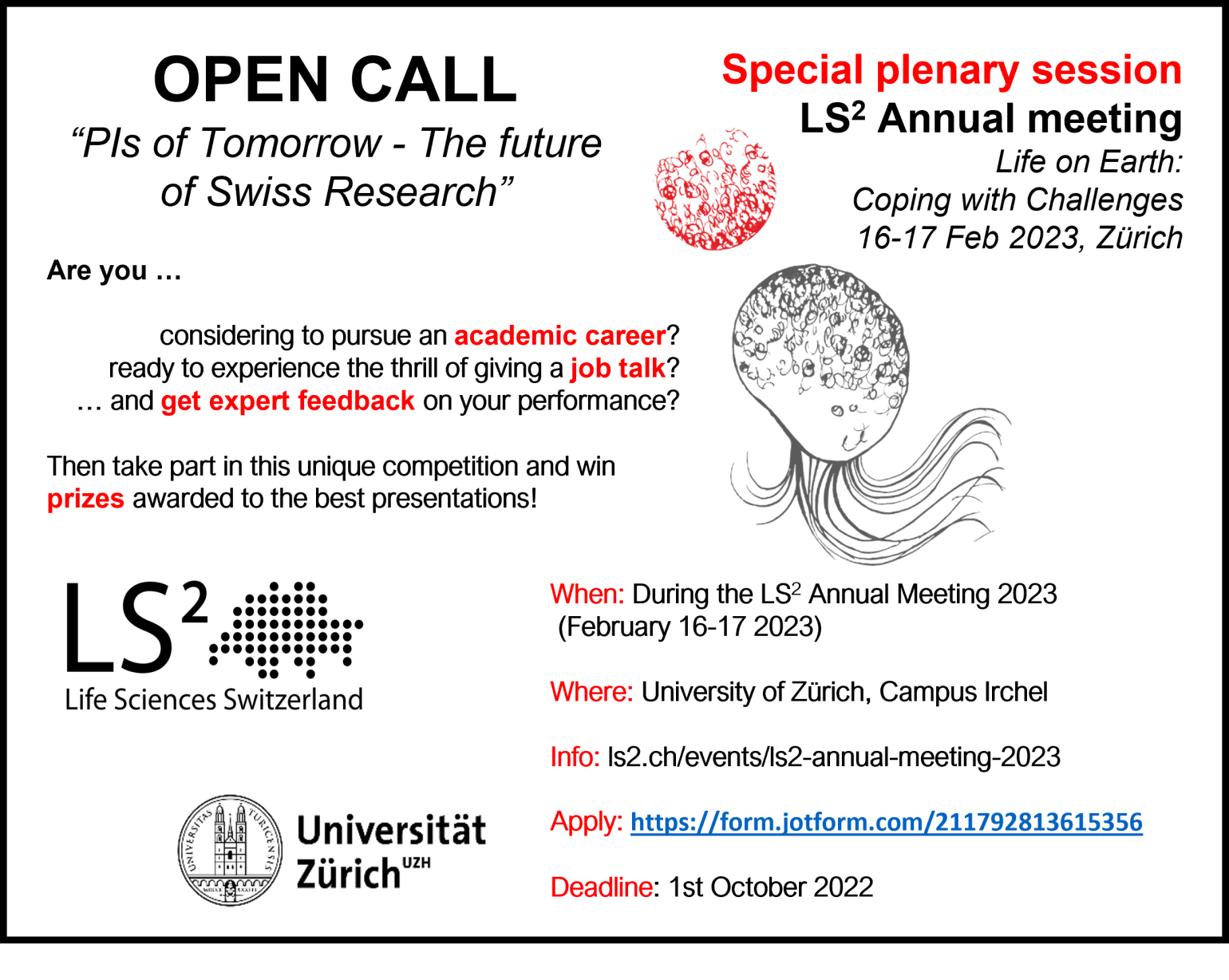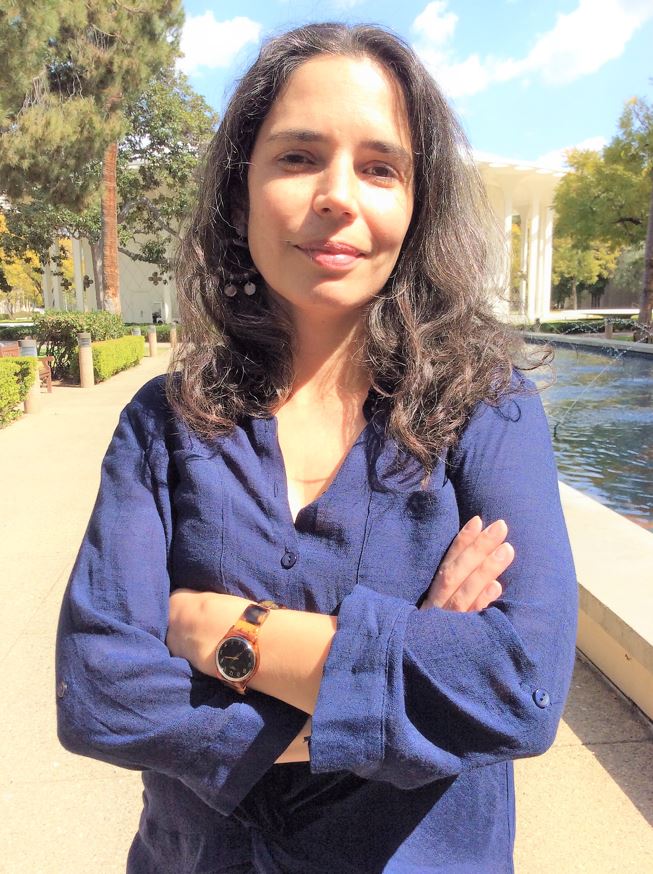PIs of Tomorrow
Congratulations to Dr Rubén D. Manzanedo (right) and Dr Bernadette Stolz (left) - the winners of the "PI`s of Tomorrow" competition at LS2AM23!
A BIG THANK YOU to sponsors of our prizes - Nikon, Medical Sciences MDPI and The FEBS Journal.

Thursday 16 February 2023 from 10:45 – 12:35
Finalists 2023
We are pleased to announce the finalists of the PIs of Tomorrow 2023:
- Dr. Ronan Kapetanovic (Friedrich Miescher Institute for Biomedical Research, Basel)
- Dr. Rubén D. Manzanedo (Plant Ecology Group, Institute of Integrative Biology, ETH Zürich)
- Dr. Mario M. Modena (Bio Engineering Laboratory, Dept. of Biosystems Science and Engineering, ETH Zurich)
- Dr. Bernadette Stolz (EPFL and the University of Oxford)
Congratulations and good luck at the final!!

Read below the research plans and statements of the finalists.
The chairs of the PIOT 2023 are:
- Dr. Lalita Oparija (University of Basel)
- Dr. Maria Constanza Maldifassi (University of Bern)
- Dr. Adam Gosztolai (EPFL)
- Dr. Oksana Iamshanova (University of Bern)
The Chairs of PIOT 2023
Dr. Ronan Kapetanovic
Title of the talk: “OutZincking” Bacteria - Deciphering the role of metal ions in the host-pathogen interactions
Research plans:
Zinc is crucial for effective immune responses and severe zinc deficiency has a catastrophic effect, increasing bacterial burdens, inflammatory responses and mortality. Some of my previous work showed that, upon infection, macrophages – first line of defense against bacteria – produce intracellular zinc-containing vesicles to poison engulfed pathogens.
One of the most common bacterial infectious diseases in humans is caused by the uropathogenic E. coli (UPEC). Indeed, ~150 million cases of urinary tract infections (UTI) are reported globally per year, affecting 50% of women and 5% of men in their lifetime. Innate immunity normally provides frontline defences against infection, but many pathogens – including UPEC - have evolved to subvert antimicrobial pathways and can colonise the host, leading to chronic disease. To make things worse, UTI are increasingly associated with treatment failure due to antibiotic resistance and can often result in life-threatening sepsis. New approaches to treat bacterial infections thus require a detailed understanding of the mechanisms UPEC use to evade the host immune responses, including zinc toxicity.
Using innovative tools generated in our lab (such as bacteria fluorescent reporter, or dual host/pathogen- single cell RNAseq), my research program will explore the mechanisms of metal ions toxicity and how pathogenic bacteria, like UPEC, subvert this antimicrobial pathway.
My future group will tackle four complementary aims:
1) By which mechanisms UPEC resist zinc and evade zinc toxicity within the macrophage?
2) Which host factors regulate the zinc toxicity pathway (transporters, storing, vesicle traffic)?
3) How fast is zinc toxicity triggered in vivo (confirming previous data with bioluminescent probes and zebrafish models)?
4) What is the role of other metal ions-mediated antimicrobial responses, and their combinative proprieties (i.e the synergy zinc/copper aka “the brass dagger”)?
Dr. Rubén D. Manzanedo
Title of the talk: "Forest biodiversity-stability relationships across spatiotemporal scales"
Research plans:
The relationship between biodiversity and stability is a long-standing question with wide ecological implications. While we understand that diversity underpins ecological stability in theory and in simple systems, complex and long-lived ones, such as forests, remain challenging due to their unique spatiotemporal scales. This question also showcases a standing challenge in ecology: addressing ecological processes across spatiotemporal scales. Particularly, the effects of long term and rare events remain poorly integrated in mainstream ecological methods and theory, but can be highly relevant to most ecosystems. I will use my past and proposed future research to illustrate how merging paleo- and neo- ecological approaches can provide uniquely relevant ecological insights in forests and beyond.
In the proposed future work, I will focus on the study of long-term biodiversity-stability relationships in natural forests by combining large tree ring databases and high-resolution satellite imagery in order to to calculate long-term response variability across scales and resilience to discrete extremes for the very same plots, and individuals across European tree species. A crucial requisite to achieve this will be the construction of a representative database of forest growth across Europe, which I will do using representativity data tools developed during my postdoctoral work, applied to existing open data.
Using this innovative dataset, I will test:
1. whether populations adapted to climatic variability also are more resilient to extremes and extreme climate weakens future populations resistance,
2. how stability across scales relates to forest diversity and composition.
3. Based on these results, I will develop temporally explicit stability metrics and use accurate location and timestamps to relate them with multi-spectral vegetation indices calculated from high-resolution satellite imagery, to create climate change scenarios that include changes in both average and extreme conditions.
Significance: This project will provide key elements to advance the study of forest responses to climate change: First, I will provide a multi-scale metric of stability, which I believe will greatly contribute to unify the confusing conceptual landscape of stability-resilience, a long-standing call within the field. Second, while the database will be an enormous future data resource by itself, showcasing the power and need to apply representativity analyses to improve big ecological datasets will be even more relevant. Given the increasing prominence of big-data analyses in ecology and the limited consideration to how representative they are, efforts to address this problem are urgently needed. Finally, integrating a data-based response to rare extreme events and ecological stability in ecological forecasts would greatly improve current species-distribution models in a simple, yet incredibly relevant way for conservation.
Dr. Mario M. Modena
Title of the talk: "In Vitro Platforms for Non-Pharmacological Combination-Therapy Identification"
Research plans:
Recently, new therapeutic strategies for cancer treatment have been proposed to improve patient survival rates, which involve the use of drug compounds in combination with externally applied stimuli, such as ultrasounds (sonodynamic therapy) or electric fields (tumor-treating fields or TT Fields). The development of these techniques is largely carried out on animal models and clinical trials have already proven the effectiveness of such treatment strategies. However, the low throughput of animal testing and the related ethical concerns strongly limit the development of these new pharmacological and non-pharmacological combinatorial interventions.
Grounded on my previous experience on 3D microtissue models and microfabrication, I will develop new in vitro platforms for cell culturing, which will provide unprecedent spatiotemporal control over external stimuli to:
(i) investigate the role of low-power ultrasounds and electrical stimulation in enhancing drug efficacy, whose mechanisms of action remain elusive;
(ii) identify new synergistic drug/stimulation therapeutic combinations.
The design of miniaturized cell-culture platforms specifically tailored to investigate these treatment strategies will allow to (i) ensure uniform and controlled exposure of cells and tissues to external stimuli and drug compounds, to, e.g., avoid the formation of ultrasound standing waves due to presence of air-liquid interfaces and wave reflection at side walls in standard well plates and to (ii) use transparent, conductive thin films for the application of uniform electric-field stimulation and simultaneous high-resolution, live microscopy.
Dr. Bernadette Stolz
Title of the talk: "Topology-based biomarkers for the quantification of complexity and heterogeneity in cancer"
Research plans:
High-resolution images of cancer tissue reveal complexity and heterogeneity of spatial organisation. These types of images are often analysed through:
- visual inspection and
- applying machine learning to count cells.
While the first is time consuming and subjective, the latter rarely gives insight into underlying mechanisms and requires large amounts of data, which are not always available. The goal of this proposal is to apply sophisticated computational methods with roots in algebra, geometry, and topology to quantify complexity and heterogeneity in cancer tissue.
Topological Data Analysis (TDA) is a mathematical field that combines concepts from pure and applied mathematics. It studies topological invariants (i.e. characteristics of shapes) such as connectedness, loops, or holes in high-dimensional data. A prominent method in TDA is Persistent Homology (PH), which can be imagined as observing data through multiple scales or resolutions. In my research I develop methods to make PH applicable for biological datasets.
In the proposed project I will quantify complexity and heterogeneity in different types of cancer tissue, using PH and develop PH biomarkers for patient stratification, disease phenotyping, treatment prediction, and treatment scheduling. I am collaborating with various oncology labs which all use different technologies.
In addition, I will use mathematical models to test and validate the topological methods, study the functional impact of observed topological features, and investigate their use for the selection of mathematical models.
Where are the past winners now?
-
- Lucia Prieto-Godino: 2017 Jury & Public Award Winner
Awarded FENS EJN Young Investigator Prize, L’Oreal-UNESCO for women in science Fellowship
Now Group Leader at the Francis Crick Institute (London, UK) - Alexander Harms: 2018 Jury Award Winner
Awarded SNSF Ambizione
Now Project Leader at Biozentrum University of Basel (CH) - Andreas Moor: 2018 Public Award Winner
Awarded SNSF Eccellenza, ERC Starting Grants
Now Professor at University of Zurich (CH) - Michael Zimmermann: 2019 Public Award Winner
Awarded SNF Advanced Postdoc.Mobility Fellowship, SwissTB Award, EMBO Long-Term Fellowship, SNF Early Postdoc.Mobility Fellowship Now Now Group Leader at EMBL (DE) - Francesca Ronchi: 2019 Jury Award co-Winner
Awarded SNSF-MHV Postdoctoral fellowship, ECCO Grant
Now Senior Scientist and Lecturer at University of Bern (CH) - Jean-Philippe Krieger: 2019 Jury Award co-Winner
Awarded an SNF postdoctoral fellowship
Now Postdoctoral Researcher at University of Gothenburg (Sweden) - Thomas O. Auer: 2020 Jury Award Winner
Awarded an Ambizione Fellowship
Group Leader ( SNFS Ambizione) at University of Lausanne (CH) - Joachim Moser von Filseck: 2020 Public Award Winner
Now Postdoctoral Researcher at the University of Geneva (CH) - Elisa Araldi: 2021 Jury Award Winner
Now Postdoctoral Researcher at the ETH Zurich (CH), department of Health Sciences and Technology - Karina Silina: 2021 Public Award Winner
Now Researcher at the Institute for Experimental Immunology, University of Zurich (CH) - Alicia Michael: 2022 Jury Award Winner
Now Postdoctoral Researcher at Friedrich Miescher Institute for Biomedical Research (CH) - Adam Gosztolai: 2022 Public Award Winner
Now a Human Frontiers Postdoctoral Fellow in the group of Pierre Vandergheynst at EPFL (CH)
- Lucia Prieto-Godino: 2017 Jury & Public Award Winner
The Call
We are very pleased to announce that the special session "PIs of Tomorrow - The Future of Swiss Research" will be held at the LS2 Annual Meeting 2023.
This session offers an opportunity for postdocs and junior researchers interested in pursuing an academic career to present a talk similar in format to a professorship application interview. A jury panel of professors will evaluate the presentations and provide feedback in a one-on-one session afterward. Only applicants with ties to Switzerland will be considered. As in 2019 in 2020, in 2021 and in 2022, the PIOT session will be again a plenary session.
The PIs of Tomorrow chairs: Dr. Lalita Oparija, Dr. Maria Constanza Maldifassi, Dr. Adam Gosztolai, Dr. Oksana Iamshanova










